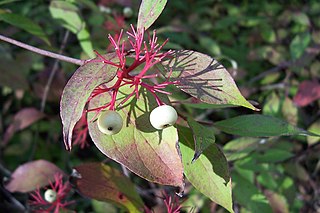
Jasmine is a genus of shrubs and vines in the olive family (Oleaceae). It contains around 200 species native to tropical and warm temperate regions of Eurasia, Africa, and Oceania. Jasmines are widely cultivated for the characteristic fragrance of their flowers. A number of unrelated plants contain the word "jasmine" in their common names.

Hypericum calycinum is a species of prostrate or low-growing shrub in the flowering plant family Hypericaceae. Widely cultivated for its large yellow flowers, its names as a garden plant include Rose-of-Sharon in Britain and Australia, and Aaron's beard, great St-John's wort, creeping St. John's wort and Jerusalem star. Grown in Mediterranean climates, widely spread in the Strandja Mountains along the Bulgarian and Turkish Black Sea coast, and also in Flanders in Belgium.

Fremontodendron, with the common names fremontia, flannelbush, and flannel bush, is a genus of three known species of shrubs native to the Southwestern United States and northwest Mexico.

Arctostaphylos uva-ursi is a plant species of the genus Arctostaphylos widely distributed across circumboreal regions of the subarctic Northern Hemisphere. Kinnikinnick is a common name in Canada and the United States. Growing up to 30 centimetres in height, the leaves are evergreen. The flowers are white to pink and the fruit is a red berry.

Cornus sericea, the red osier or red-osier dogwood, is a species of flowering plant in the family Cornaceae, native to much of North America. It has sometimes been considered a synonym of the Asian species Cornus alba. Other names include red brush, red willow, redstem dogwood, redtwig dogwood, red-rood, American dogwood, creek dogwood, and western dogwood.

Rhus trilobata is a shrub in the sumac genus (Rhus) with the common names skunkbush sumac, sourberry, skunkbush, Squawbush, and three-leaf sumac. It is native to the western half of Canada and the Western United States, from the Great Plains to California and south through Arizona extending into northern Mexico. It can be found from deserts to mountain peaks up to about 7,000 feet (2,100 m) in elevation.

Prunus subcordata, known by the common names Klamath plum, Oregon plum, Pacific plum and Sierra plum, is a member of the genus Prunus, native to the western United States, especially California and Oregon.

Ceanothus ophiochilus is a rare species of flowering shrub known by the common name Vail Lake ceanothus, native to Southern California. It was not described until 1991.

Sambucus racemosa is a species of elderberry known by the common names red elderberry and red-berried elder.

Ribes aureum, known by the common names golden currant, clove currant, pruterberry and buffalo currant, is a species of flowering plant in the genus Ribes. It is native to Canada, most of the United States and northern Mexico. The variety Ribes aureum var. villosum is sometimes considered a full species, Ribes odoratum.

Arctostaphylos montaraensis, known by the common name Montara manzanita, is a species of manzanita in the family Ericaceae.
Arctostaphylos pilosula is a species of manzanita, known by the common names La Panza manzanita and Santa Margarita manzanita, that is endemic to California.

Arctostaphylos silvicola is a species of manzanita known by the common names Bonny Doon or silverleaf manzanita. It is endemic to the sandhills of the southern Santa Cruz Mountains in California's Santa Cruz and Santa Clara counties.

Ceanothus sonomensis, with the common name Sonoma ceanothus, is a rare species of shrub in the family Rhamnaceae. It is endemic to northern California.
Syntrichopappus is a genus of flowering plants in the family Asteraceae, found in the Southwestern United States and northern Mexico, including Baja California. It is a member of the Heliantheae alliance of the Asteraceae. There are two species. Common names include xerasid and Frémont's-gold.

Howellanthus is a monotypic genus of flowering plants in the borage family containing the single species Howellanthus dalesianus, commonly known as Scott Mountain phacelia or Howell's phacelia. Until 2010 the plant was known as Phacelia dalesiana. It is endemic to the southern Klamath Mountains of northern California, including the Scott Mountains for which it is named. It grows in mountain forests and meadows.

Salvia munzii is a semi-evergreen perennial species of sage known by the common name Munz's sage or San Miguel Mountain sage. It is native to northern Baja California, Mexico, and it can be found in a few locations just north of the border in San Diego County, California, where it is particularly rare. It is characterized by small leaves and clear blue flowers. It is a member of the coastal sage scrub and chaparral plant communities.
Tetracoccus ilicifolius is a rare species of flowering shrub in the family Picrodendraceae known by the common names hollybush and holly-leaved tetracoccus.

Prosartes, the fairybells, is a North American genus of flowering plants in the lily family.
Mary Caroline Foster DeDecker was an American botanist, conservationist, environmentalist and founder of the Bristlecone Chapter of the California Native Plant Society. She discovered six new plants, three of which, including Dedeckera eurekensis, are named in her honor. Dedeckera Canyon, south of Eureka Dunes, is also named after her.

















